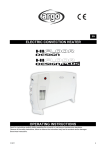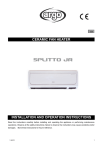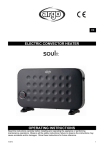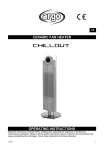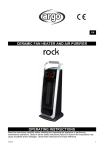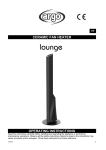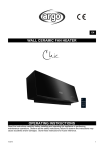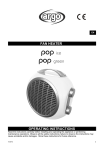Download Argoclima Hi Floor Classic
Transcript
EN ELECTRIC CONVECTION HEATER OPERATING INSTRUCTIONS Read the instructions carefully before operating the convector or carrying out maintenance operations. Observe all the safety instructions; failure to observe the instructions may lead to accidents and/or damages. Store these instructions. V 05/10 1 GENERAL SAFETY INFORMATION • Use this convector only as outlined in this manual. Any other use not recommended by the manufacturer may cause fire, electric shock or injury to persons. • Ensure that the mains voltage complies with that indicated on the convector data plate (220-240VAC/50Hz). • Remove the convector from its packaging and check that it is in good condition before use. Keep any plastic bags away from children. • Check the cord and plug before using the convector to ensure that they have not been damaged during transport. • This convector is not a toy. Children should be adequately supervised to ensure that they do not play with the panel. • This convector is not suitable for use by persons (including children) with reduced physical, sensory or mental abilities, or without the necessary experience and knowledge, unless they are adequately supervised and have been instructed concerning use of the convector by a person responsible for their safety. • This convector is designed for domestic use. It must not be used for commercial or industrial purposes. • Disconnect the mains power when the appliance is not used or for cleaning operations. • To disconnect the convector, set the selector to 0 and remove the plug from the socket. Pull on the plug only. Do not pull the cord. • Avoid placing fingers or foreign objects in the air inlet/outlet grilles, as this may lead to electric shock or fire and may damage the convector. To avoid the risk of fire, do not block the grilles or tamper with them in any way while the convector operates. • Do not use the convector if the cord or plug is damaged. If the power supply cord is damaged, it must be replaced by the manufacturer, dealer or a similarly qualified person so as to avoid any safety risks. • Do not place any objects on the cord and do not bend it. During operation, the cord must be entirely unwound. • It is not advisable to use extension cords, as these may overheat and cause the risk of fire. Do not use a single extension cord to operate more than one convector. • The convector heats up significantly during operation. Risk of burn. To avoid injury, do not allow skin to come into contact with a hot surface. Use the handle to move the convector. Keep flammable materials, such as furniture, cushions, blankets, paper, cloths, curtains and suchlike at least 1 m from the front and back • Do not immerse the cord, plug or any other element of the panel in water or other liquids. • Do not touch the plug or convector with wet hands. • Avoid using the convector in dusty environments or in the presence of flammable vapours (e.g. in workshops or garages). • Do not place the convector above or near another heat source. WARNING: AVOID COVERING THE CONVECTOR TO PREVENT IT FROM OVERHEATING. The symbol below signals the above warning: • The convector may cause risk of fire if, while in operation, is covered by or comes into contact with flammable material including curtains, drapery, blankets, etc. KEEP THE CONVECTOR AWAY FROM THESE MATERIALS. • Do not insert and avoid accidental insertion of any external objects into the ventilation or discharge outlets as this may lead to electric shock, fire or damage the convector. • A convector contains parts that generate arcs or sparks. It must not be used in potentially dangerous areas such as areas at risk of fire or explosion, or areas loaded with chemical substances or humidity. • Do not use the convector on soft surfaces such as beds, where the grilles may be covered. Always stand the convector on a flat, stable surface when in operation, in order to prevent it from overturning. Arrange the cord in such a way that the convector and other objects do not rest on it. Do not run the cord under carpets. Do not cover the cord with blankets, carpets or similar materials. Place the cord far away from busy areas, or in a place where it cannot be accidentally pulled-out. • This convector cannot be used in bathrooms, laundry rooms, next to a shower or swimming pool or in similar indoor environments. Never position the convector where it may fall into a bath or other containers of water. • Never position the convector on a wet floor. • In any case, the adjustment knobs must never be accessible by anyone in a bath or shower. • Do not position the convector below an electric socket. • The socket must be earthed. • Do not allow the electric cord to touch the metal structure of the convector when it is hot or in operation, in order to avoid the high temperatures ruining the cord. • Do not operate the convector outdoors. Do not use the convector in front of or near an open window. V 05/10 2 WARNING: do not use the convector with a controller or any other device that activates the convector automatically, as there may be a risk of fire if the convector is covered or incorrectly positioned. • Upon initial start-up, the convector may emit a slight, harmless smell. This smell is a normal effect of the initial heating up of the internal heating elements, and should not recur later on. • Do not attempt to repair, disassemble or modify the convector. The convector does not contain parts that can be repaired by the user. • Turn the switch off and unplug before carrying out any maintenance work or moving the convector. Always unplug from the socket when the convector is not in use. WARNING: ALWAYS UNPLUG WHEN CARRYING OUT MAINTENANCE WORK OR MOVING THE CONVECTOR. • Do not place anything on the convector; avoid placing wet garments on the convector. • Turn the appliance off if unattended in order to avoid accidents. • If the convector is not used for prolonged periods, disconnect the plug, replace the convector in its box and store it in a dry, ventilated place. • Ensure that the air inlet /outlet are not close to walls or curtains when the convector is in use, so as to avoid obstructing the convector and hampering its efficiency. • Should you hear an abnormal noise or detect an unusual smell when using the convector, cease use and unplug immediately. • Do not expose the elderly or children to a continuous flow of air. • Do not use the convector if it has been damaged or dropped. WARNING: THE ON/OFF SWITCH IS NOT THE ONLY MEANS TO DISCONNECT THE POWER SUPPLY. ALWAYS PULL OUT THE PLUG FROM THE SOCKET IN THE EVENT OF MAINTENANCE OPERATIONS, WHEN MOVING THE PANEL OR WHEN NOT IN USE. DESCRIPTION OF PARTS E A. Thermostat - L (low temperature) - H (high temperature) A B B. F C. D Forced ventilation and power selector 1 = 1000W (min.) 2 = 2000W (max.) u = turbo (forced ventilation) Feet D. Forced air outlet (turbo mode) C E. Air outlet (front) and intake (back) grille F. 60-minute timer (HI FLOOR CLASSIC T model) The convector is available in two different versions: HI FLOOR CLASSIC - Min./max. power 1000/2000 W – Thermostat and power selector with turbo HI FLOOR CLASSIC T - Min./max. power 1000/2000 W – Thermostat and power selector with turbo and 60-minute timer. V 05/10 3 HOW TO ASSEMBLE THE FEET SUPPLIED The convector is packed without feet. These must therefore be assembled before using the appliance. To fix the feet supplied to the convector base, insert each at one of the two sides of the base, and slide them to the limit stop. View from below of the side of the convector base without the foot fitted. Convector foot to be inserted laterally in the specific space. The foot must be allowed to slide along the specific grooves, in the direction indicated by the arrows . The foot is now correctly assembled. HOW TO USE THE CONVECTOR Choose a suitable place to position the convector, considering the general safety warnings given in the first part of this manual. Only use this convector in an upright position. Insert the plug into the electrical socket, ensuring that voltage is compliant with that specified on the convector data plate. Select the desired temperature using the thermostat: L means low temperature and H means high temperature. The convector will only start operating only if the thermostat is above minimum temperature (turn the thermostat in a clockwise direction - from L to H). Now choose the desired power level and turbo mode if required, using the power selector as shown in the image below. 1 - Low power (1000 Watts) 2 - High power (2000 Watts) u - High power (2000 Watts) + forced ventilation (turbo) By turning the thermostat dial, the temperature can be regulated as desired. Remember that once the temperature has been set, the convector will operate until this temperature is reached and then maintain the temperature by turning itself on and off as necessary. To turn the convector off completely turn the power selector back to 0 and then rotate the thermostat dial anticlockwise until it clicks off. Unplug the appliance if it will not be used for a while. V 05/10 4 OPERATING TIMER (HI FLOOR CLASSIC T model) The HI FAN CLASSIC T model is equipped with a very simple timer that allows for the programming of convector operation from 1 to 60 minutes. Indicator set to OFF: the convection heater stops operating. Use of the timer function (from 0 to 60 minutes): turn the timer dial clockwise and set the number of minutes for which you wish the appliance to function. Indicator set to ON: the convection heater functions continuously. OVERHEATING SAFETY DEVICE In the event of overheating, the convector protection system automatically disables the heating elements, turning the appliance off. To understand whether it has turned off due to intervention by this system, rotate the thermostat switch to maximum temperature (H) to verify that the thermostat has not simply turned the convector off due to having reached the set temperature. Should the appliance not return to normal operation due to the safety device having intervened: 1. turn the convector off; 2. remove any cause of overheating (e.g. obstacles on the air outlet or intake grille, dust deposits in the appliance, etc.); 3. leave the appliance to cool for 15 – 20 minutes; 4. turn the convector on again. HOW TO CLEAN THE CONVECTOR • Always unplug and leave the convector to cool before cleaning. • Use a damp cloth to clean the convector exterior and remove dust. Leave the casing to dry before using the convector again. • Do not allow water to enter the convector. • Do not use benzene, solvents or abrasive compounds to clean the convector, as these may damage the casing. • Use a vacuum cleaner to remove dust from the air inlet/outlet grilles. • Ensure that the convector is dry before inserting the plug. • Do not use metal tools to clean the convector. Any metal fragments that may detach may come into contact with the panel’s electrical components and cause a short-circuit. • In the event of malfunctions or damages, always contact an authorised service centre. STORING THE CONVECTOR If the convector is not used for prolonged periods, it must be stored together with this manual in its original packaging, in a cool and dry place. Never put the appliance away when still hot. Always wait for it to cool down. INFORMATION ON PROPER DISPOSAL OF THE APPLIANCE IN COMPLIANCE WITH EUROPEAN DIRECTIVE 200/94/EC. When this appliance reaches the end of its useful life, it must not be disposed of together with household waste but must be delivered to appropriate separate waste disposal plants or to dealers that provide similar service. Separate waste disposal of electrical and electronic appliances prevents possible negative effects on the environment and human health resulting from inadequate disposal, and also allows for recovering and recycling the materials comprising the appliances to ensure significant saving in terms of energy and resources. The separate disposal obligation is underlined by the crossed-out dustbin symbol appearing on the product. Illegal disposal of the product by the user shall determine the application of the administrative sanctions defined by the regulations in force. www.argoclima.com MADE IN CHINA V 05/10 5





